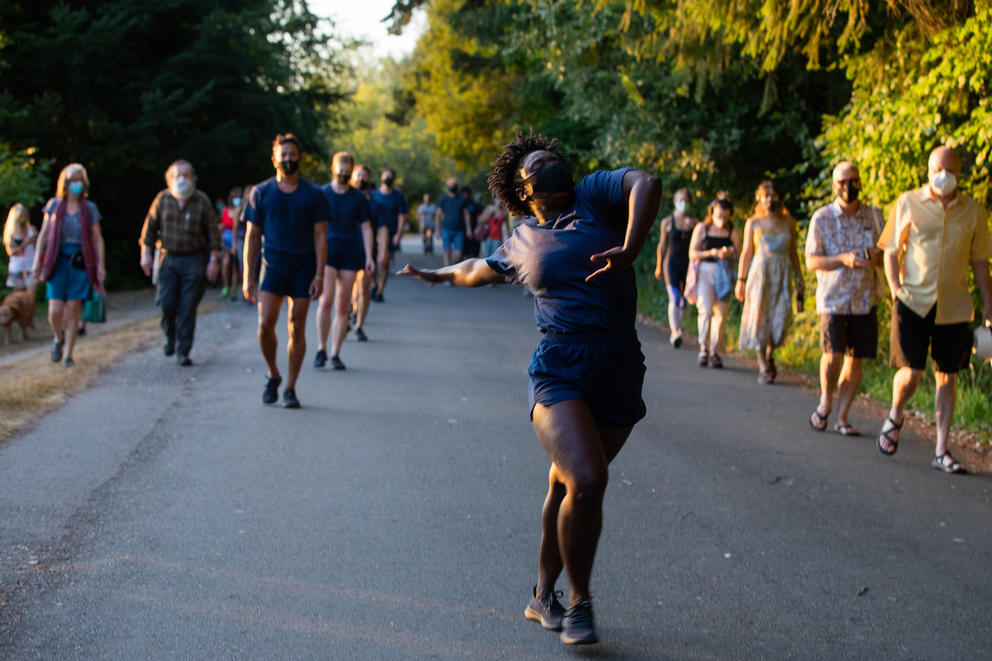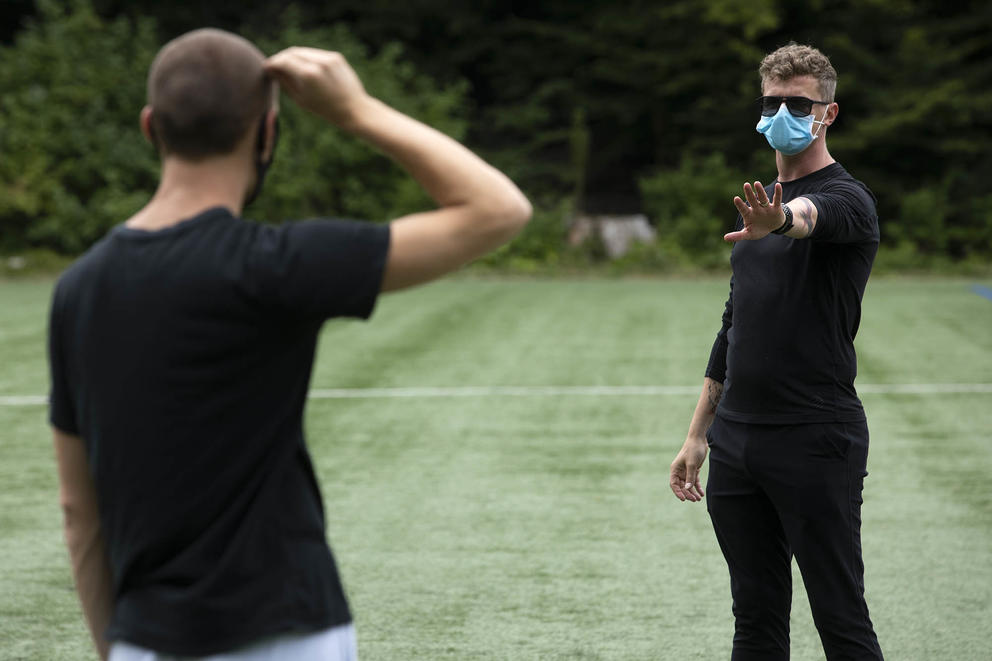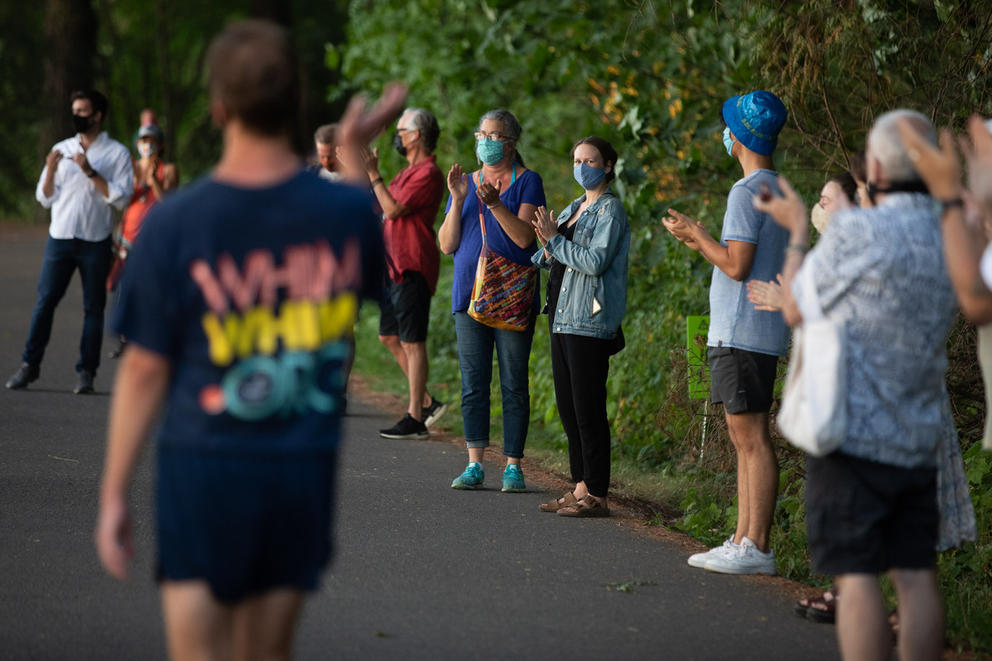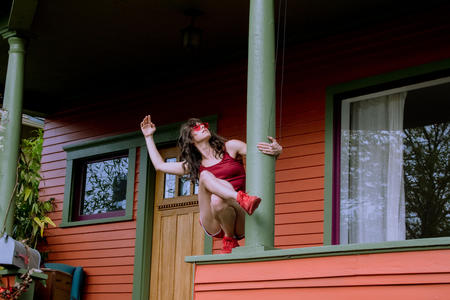Physical distancing, and the coronavirus at large, has profoundly complicated how (and if) dancers and choreographers work. But Wevers, founder and artistic director of Seattle dance company WHim W’Him, has found a way to keep creating and performing under the constraints: By rehearsing on the turf of a public playfield, maintaining a 6-foot radius around the dancers at all times, and, most notably, by bringing performance to where people are gathering this season: outside.
Throughout August and September, Whim W’Him dancers are performing Wevers’ newest choreography, the pandemic-inspired The Way It Is, in parks across the city. The exact location of each pop-up dance will be announced the day of the performance.
“I was thinking it would be great to perform in Seattle and offer free performances so that we can actually be seen, be present in our community and have a real sense of human connection,” Wevers says.
Catching a glimpse of the group isn’t like sitting in a theater: rather than being boxed in by a stage, the dancers twirl, whirl, duck and jump in a forward-moving row (imagine a conga line with no touching, less cheer and more elegant lockstep). Wevers calls it a 1.1-mile-long dance procession. It’s a clever trick to ensure that the audience doesn’t congregate, but Wevers says it’s also a metaphorical representation of moving through the stages of grief, a call to dance around obstacles and press on, and an attempt to imagine a way forward.
“As artists, we have this urge to create,” he says. “Our mission is to create new contemporary dance works. How do we make that happen with what we have? You have to be creative and use the tools that you have right now.”
Wevers is not the only choreographer who, after the pandemic stopped live dance in its tracks, has regained momentum with a graceful pivot. Others, mostly with smaller dance companies, have found creative solutions for the industrywide coronavirus conundrum, including drive-in dance performances, socially distanced outdoor dance festivals and a growing body of dance films.
“The thing with artists is that when they can't continue practicing their art, they become miserable. The biggest draw for dancers is this ability to express yourself through movement,” says James Yoichi Moore of Seattle Dance Collective.
Moore founded SDC last year with fellow Pacific Northwest Ballet principal Noelani Pantastico. The intention was to expand upon their first successful season with another round of indoor, staged performances. When the coronavirus hit, they swiftly pivoted to film. Throughout July, SDC premiered five brand-new dance pieces “for the digital stage” — meaning dance films streaming on its website — under the banner Continuum: Bridging the Distance. The films, many featuring out-of-work dancers (including Pantastico, Moore and others from Pacific Northwest Ballet), will be released as one continuous film Thursday (Aug. 6).
“It was kind of a no-brainer for us to create this program and offer artists an opportunity to work,” Moore says.
It did take some getting used to. Dance films are not new, but for many choreographers and dancers, working in a new medium and in new venues (mostly outdoors) has upended their usual processes.
For The Only Thing You See Now, dancers Miles Pertl and Leah Terada (who live together and could thus safely dance as a duo) arabesqued over the edge of a rickety Alki boat dock rocked by waves, leaning over but never falling in. In the physically but not emotionally distant pas de deux The Space Between Us, Pantastico and Moore try to connect through the glass windows of the rooftop restaurant Mbar, gesturing on either side (Moore, for his part, outside in the rain).
It was a strange experience, Pantastico says, to have to do take after take, to feel the eye of the camera up close, instead of being watched by audience members in the dark.
But, “in life, change is inevitable. Some change is forced upon you, and you just have to adapt,” Pantastico says. “We just have to keep going, keep brainstorming, keep pushing, keep embracing things that are out of our comfort zone. That's the only way that we're going to survive.”
Pantastico hopes Continuum: Bridging the Distance is a start, perhaps even a template for larger dance organizations to emulate. “We're waiting for the bigger companies to take action like this and do things that are a little bit more creative outside the box,” she says. “I'm hoping it happens, because I don't see us going back to the theater for a very long time.”
Wevers of Whim W’Him fears the same; no theater shows until there’s a vaccine, he says. That’s why he’s pivoting to all-digital seasons until at least September 2021. With the help of New York filmmaker and dancer Quinn Wharton, the company has reconceptualized two dance pieces (originally slated to premiere on stage this spring) for video: The Way It Is by Wevers and Manifold by Penny Saunders. Now the two dance films will premiere on Aug. 13 on IN-WITH-WHIM, the company’s new streaming website. For $120 a year or $15 a month, subscribers can also access videos of past performances, rehearsal livestreams (both on Zoom and outdoors), artist interviews and new creations set to premiere later this fall and into next year.
The priority in creating a digital season, Wevers says, was to keep the dancers safe and employed. “This is their way of living, their salary,” he says.
“That has been the priority from the very beginning: How do we get back to work safely? How do we make this happen? How are we as a dance company going to be able to create what we need to create? Dancers, we touch each other. We breathe on top of each other very heavily in a small room and that's obviously really bad for what's going on.”
For the time being, live entertainment is generally prohibited in Washington state. Online dance films are a fine fix, and the genre also allows for new experimentation and audiences beyond local borders. But it’s still a stopgap solution.
Many dancers live and breathe for the thrill of live performance, where there is only one take.
“When you film a dance film, you film 30 seconds and then do it five times so you get the best take,” Wevers says. “Our dancers are used to performing big pieces for 20, 25 minutes without a break. It's like a marathon. When things go wrong, you adjust and you keep going. It's more like a puzzle. So they are really excited about it having that feeling again of: ‘Hey, we're going to be performing. People are going to be watching us. And we're not going to be able to stop and do it again. We just have to keep going.’ ”
On a recent summer night in Jefferson Park, during one of the first performances of “The Way It Is,” there was no stage, no dimming of the lights (though the sun was slowly setting, casting the park in a dramatic glow), no curtain rising. Only a row of masked, uniformed Whim W’Him dancers, who marched along the park’s path until they erupted into wide arm movements as if swimming upstream. Kids suspended their playground games, watching with mouths open as members of the troupe weaved in and out of line, tethered to an invisible center as they made their way through the park. A group of bemused barbecuers whipped out their phone cameras to catch the dancers in action before they leaped forward out of the frame.
Get the latest in local arts and culture
This weekly newsletter brings arts news and cultural events straight to your inbox.









